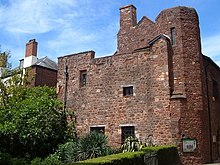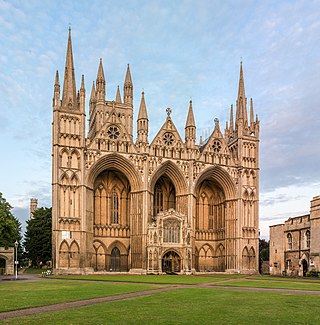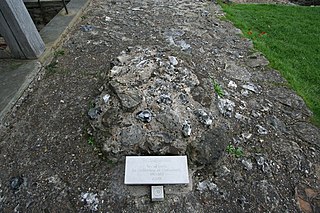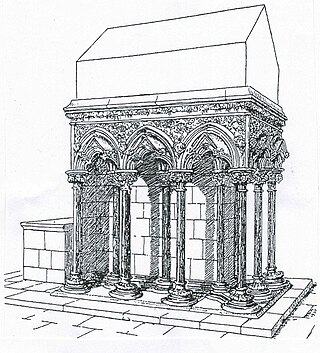
Various monasteries and other religious houses have existed at various times during the Middle Ages in the city of Exeter, Devon, England. [1]

Various monasteries and other religious houses have existed at various times during the Middle Ages in the city of Exeter, Devon, England. [1]
The monastic buildings in Exeter included:
The origins of monasticism in Exeter are uncertain. Christianity arrived in Britain when Exeter was still a Roman city [12] and the area's military and civic capital. However, the end of Roman rule in Britain led to the city being nearly abandoned for over 400 years. [13] During the Post-Roman period it was part of the Romano-British kingdom of Dumnonia. Celtic Christianity was introduced to the area during the fifth century by Welsh, Irish and Breton missionaries [12] and a church and cemetery are thought to have existed on the site of the present Exeter Cathedral at this time. [13] The defeat of the British in 682 by King Centwine of Wessex allowed the Saxons to reach Exeter, [12] and in the late seventh century the church appears to have become a monastery under abbot Wulfhard. [13] The Saxons gave the name Monkton to Exeter as a consequence of the large number of monks that it contained. [14] According to Willibald, an Anglo-Saxon priest who wrote a "Life" of Saint Boniface, the saint was educated at a monastery in 690 in a place variously called Adestancester, Escancastre, or Examchester, [15] names that have been identified with Exeter. [14]
During the tenth century the population of Exeter grew to around 2,000 and the monastery was re-founded as a minster church by King Æthelstan in c. 930. The foundations of the minster were discovered in 1971 under the parish church of St Mary Major when it was demolished. King Edgar reintroduced monks to the city in 968 under the rule of Bishop Sideman, the Bishop of Crediton. A monastic revival was encouraged by the king during his reign and he identified Exeter as a place suitable for monks to join the clergy. [13] Exeter was sacked by the Danes in 1003, but the Benedictine monastery was restored by Cnut in 1019. [16] [17]
Bishop Leofric was appointed as Bishop of Cornwall and Bishop of Crediton in 1046. In 1050 he merged the two bishoprics to create the united see of Devon and Cornwall and moved the episcopal see to Exeter. [15] [18] The new combined see incorporated Exeter's three monastic buildings of the time, all of which were located in Saint Peter's Close. The nunnery of Saint Augustine, the Saxon monastery and the Benedictine monastery were united to form the Cathedral Church. [1] The monastery was suppressed and converted into a secular cathedral. [19]
During the subsequent two centuries a number of priories and friaries were founded. These were all dissolved with the Dissolution of the Monasteries under Henry VIII and little remains. There is one building surviving from Polsloe Priory: the main part of the west range, built of the local red sandstone and believed to date from around 1320. [20] Nothing is extant from St James Priory except a cob wall surrounding the building currently on the site, which may be the precinct wall of the priory. [8] Parts of the Benedictine Priory of St Nicholas survive. The guest wing and a kitchen at its northern end were converted into an Elizabethan town house after dissolution, and this is now maintained as St Nicholas' Priory museum by Exeter City Council. [7] The refectory was used as a Georgian town house and is now owned by the Exeter Historic Buildings Trust. [21]

Peterborough Cathedral, properly the Cathedral Church of St Peter, St Paul and St Andrew, and formerly known as Peterborough Abbey or St Peter's Abbey, is a cathedral in Peterborough, Cambridgeshire, in the United Kingdom. The seat of the Anglican Bishop of Peterborough, it is dedicated to the Apostles Saint Peter, Saint Paul, and Saint Andrew, whose statues look down from the three high gables of the West Front. Founded in the Anglo-Saxon period as a minster it became one of England's most important Benedictine abbeys, becoming a cathedral only in 1542. Its architecture is mainly Norman, following a rebuilding in the 12th century. Alongside the cathedrals of Durham and Ely, it is one of the most important 12th-century buildings in England to have remained largely intact, despite extensions and restoration, and is one the nations best preserved pre-Reformation abbeys.

Minster is an honorific title given to particular churches in England, most notably York Minster in Yorkshire, Westminster Abbey in London and Southwell Minster in Nottinghamshire.

A double monastery is a monastery combining separate communities of monks and of nuns, joined in one institution to share one church and other facilities. The practice is believed to have started in the East at the dawn of monasticism. It is considered more common in the monasticism of Eastern Christianity, where it is traceable to the 4th century. In the West the establishment of double monasteries became popular after Columbanus and sprang up in Gaul and in Anglo-Saxon England. Double monasteries were forbidden by the Second Council of Nicaea in 787, though it took many years for the decree to be enforced. Double monasteries were revived again after the 12th century in a significantly different way when a number of religious houses were established on this pattern among Benedictines and possibly the Dominicans. The 14th-century Bridgittines were purposely founded using this form of community.

Alien priories were religious establishments in England, such as monasteries and convents, which were under the control of another religious house outside England. Usually the mother-house was in France.

Holy Trinity Church is a Church of England parish church in Westbury-on-Trym, Bristol, England.

Events from the 7th century in England.

The Benedictine Priory of St Nicholas or just St Nicholas Priory was a Benedictine monastery founded in Exeter, England, in 1087. At the Dissolution of the Monasteries the church and chapter house range were pulled down but the domestic buildings were left intact. Parts of the north and west ranges of the monastery survive with the west range now being a museum owned by Exeter Historic Buildings Trust.

Ely Abbey was an Anglo-Saxon monastic establishment on the Isle of Ely first established in 673 by Æthelthryth the daughter of Anna, King of East Anglia. The first establishment was destroyed by the Danes in 870, but Edgar, King of England re-established the monastery in 970 as part of the English Benedictine Reform.
Saint Eanswith, also spelled Eanswythe or Eanswide, was an Anglo-Saxon princess, who is said to have founded Folkestone Priory, one of the first Christian monastic communities for women in Britain. Her possible remains were the subject of research, published in 2020.

St Oswald's Priory was founded by Æthelflæd, daughter of Alfred the Great, and her husband Æthelred, ealdorman of Mercia, in the late 880s or the 890s. It appears to have been an exact copy of the Old Minster, Winchester It is a Grade I listed building.
Polsloe Priory, also known as St Katherine's Priory, was a Benedictine priory for women in Devon, England. It was founded in around 1159 on land to the east of Exeter, on a site that is now part of the city's suburb of Polsloe. At the time it was the only religious house for women in Devon, but two others were founded later: at Cornworthy and Canonsleigh Abbey. The first prioress of whom any record survives was Avelina in 1218. Amongst the holdings of the priory was the Church of St Mary, Marston Magna in Somerset.

Monks Kirby Priory was a Benedictine priory established in 1077 in Monks Kirby, Warwickshire, England. The priory was suppressed in 1415 when its estates and revenues were given to the Carthusian priory of Axholme in Lincolnshire, in whose possession they continued until the Reformation. Remains of the priory form part of Monks Kirby village church today.
Osburh was a Saint in Coventry, probably Anglo-Saxon but see below. Nothing about her life has survived to the present day. Her mortal remains were enshrined at Coventry. Close to the Forest of Arden, Coventry was at that time a tiny settlement.

St Mary's Priory and Cathedral was a Roman Catholic institution in Coventry, England, founded in the 12th century by transformation of the former monastery of St Mary, and destroyed during the Dissolution of the Monasteries in the early 16th century. It was located on a site north of Holy Trinity and the former St Michael's parish churches in the centre of the city, on a site bordered by Priory Row to the south, Trinity Street to the west, and the River Sherbourne to the north. Excavated remains from the west end of the cathedral are open to the public.

The English Benedictine Reform or Monastic Reform of the English church in the late tenth century was a religious and intellectual movement in the later Anglo-Saxon period. In the mid-tenth century almost all monasteries were staffed by secular clergy, who were often married. The reformers sought to replace them with celibate contemplative monks following the Rule of Saint Benedict. The movement was inspired by Continental monastic reforms, and the leading figures were Dunstan, Archbishop of Canterbury, Æthelwold, Bishop of Winchester, and Oswald, Archbishop of York.

The Church of St Mary Major, formerly Exeter Minster, was a historic church and parish in the City of Exeter, Devon, dating from the 7th century. It pre-dated the first Exeter Cathedral by some five centuries, was rebuilt several times, but was finally demolished in 1971. It was situated to the immediate south-west of Exeter Cathedral, the site today being a grass lawn.
Adestancester.